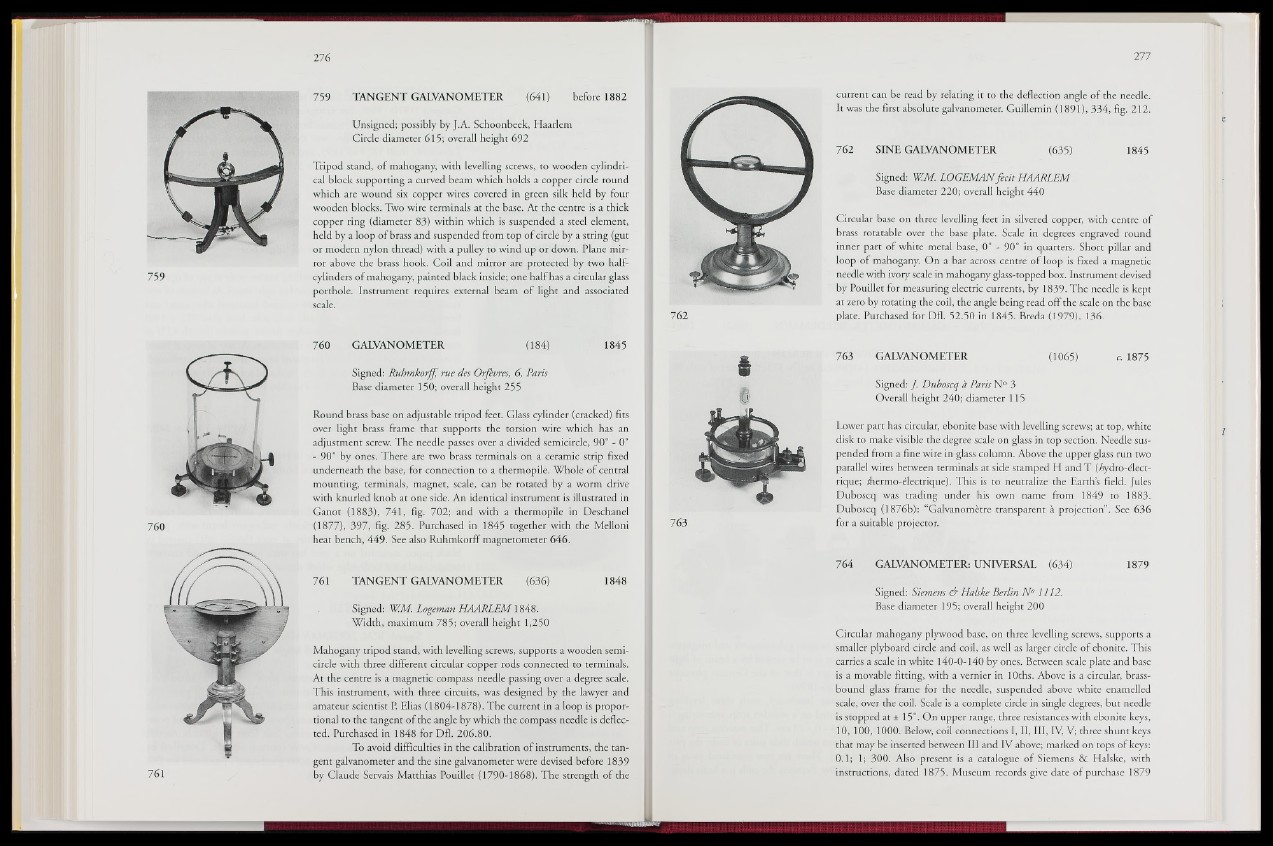
759 TANGENT GALVANOMETER (641) before 1882
Unsigned; possibly by J.A. Schoonbeek, Haarlem
Circle diameter 615; overall height 692
Tripod stand, of mahogany, with levelling screws, to wooden cylindrical
block supporting a curved beam which holds a copper circle round
which are wound six copper wires covered in green silk held by four
wooden blocks. Two wire terminals at the base. At the centre is a thick
copper ring (diameter 83) within which is suspended a steel element,
held by a loop of brass and suspended from top of circle by a string (gut
or modern nylon thread) with a pulley to wind up or down. Plane mirror
above the brass hook. Coil and mirror are protected by two halfcylinders
of mahogany, painted black inside; one half has a circular glass
porthole. Instrument requires external beam of light and associated
scale.
760 GALVANOMETER (184) 1845
Signed: Ruhmkorff, rue des Orfèvres, 6, Paris
Base diameter 150; overall height 255
Round brass base on adjustable tripod feet. Glass cylinder (cracked) fits
over light brass frame that supports the torsion wire which has an
adjustment screw. The needle passes over a divided semicircle, 90° - 0°
- 90° by ones. There are two brass terminals on a ceramic strip fixed
underneath the base, for connection to a thermopile. Whole of central
mounting, terminals, magnet, scale, can be rotated by a worm drive
with knurled knob at one side. An identical instrument is illustrated in
Ganot (1883), 741, fig. 702; and with a thermopile in Deschanel
(1877), 397, fig. 285. Purchased in 1845 together with the Melloni
heat bench, 449. See also Ruhmkorff magnetometer 646.
761 TANGENT GALVANOMETER (636) 1848
Signed: W.M. Logeman HAARLEM 1848.
Width, maximum 785; overall height 1,250
Mahogany tripod stand, with levelling screws, supports a wooden semicircle
with three different circular copper rods connected to terminals.
At the centre is a magnetic compass needle passing over a degree scale.
This instrument, with three circuits, was designed by the lawyer and
amateur scientist P. Elias (1804-1878). The current in a loop is proportional
to the tangent of the angle by which the compass needle is deflected.
Purchased in 1848 for Dfl. 206.80.
To avoid difficulties in the calibration of instruments, the tangent
galvanometer and the sine galvanometer were devised before 1839
by Claude Servais Matthias Pouillet (1790-1868). The strength of the
current can be read by relating it to the deflection angle of the needle.
It was the first absolute galvanometer. Guillemin (1891), 334, fig. 212.
762 SINE GALVANOMETER (635) 1845
Signed: W.M. LOGEMAN fecit HAARLEM
Base diameter 220; overall height 440
Circular base on three levelling feet in silvered copper, with centre of
brass rotatable over the base plate. Scale in degrees engraved round
inner part of white metal base, 0° - 90° in quarters. Short pillar and
loop of mahogany. On a bar across centre of loop is fixed a magnetic
needle with ivory scale in mahogany glass-topped box. Instrument devised
by Pouillet for measuring electric currents, by 1839. The needle is kept
at zero by rotating the coil, the angle being read off the scale on the base
plate. Purchased for Dfl. 52.50 in 1845. Breda (1979), 136.
763
763 GALVANOMETER (1065) c. 1875
Signed: J. Duboscq à Paris N° 3
Overall height 240; diameter 115
Lower part has circular, ebonite base with levelling screws; at top, white
disk to make visible the degree scale on glass in top section. Needle suspended
from a fine wire in glass column. Above the upper glass run two
parallel wires between terminals at side stamped H and T (/ydro-élect-
rique; diermo-électrique). This is to neutralize the Earths field. Jules
Duboscq was trading under his own name from 1849 to 1883.
Duboscq (1876b): “Galvanomètre transparent à projection”. See 636
for a suitable projector.
764 GALVANOMETER: UNIVERSAL (634) 1879
Signed: Siemens & Halske Berlin N° 1112.
Base diameter 195; overall height 200
Circular mahogany plywood base, on three levelling screws, supports a
smaller plyboard circle and coil, as well as larger circle of ebonite. This
carries a scale in white 140-0-140 by ones. Between scale plate and base
is a movable fitting, with a vernier in lOths. Above is a circular, brass-
bound glass frame for the needle, suspended above white enamelled
scale, over the coil. Scale is a complete circle in single degrees, but needle
is stopped at ± 15°. On upper range, three resistances with ebonite keys,
10, 100, 1000. Below, coil connections I, II, III, IV, V; three shunt keys
that may be inserted between III and IV above; marked on tops of keys:
0.1; 1; 300. Also present is a catalogue of Siemens & Halske, with
instructions, dated 1875. Museum records give date of purchase 1879